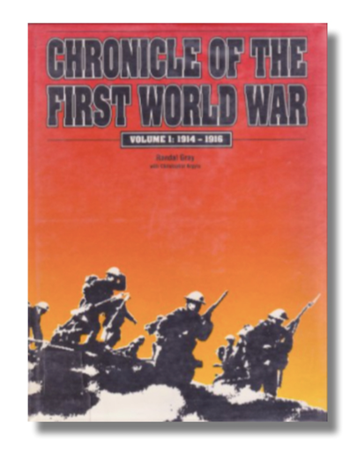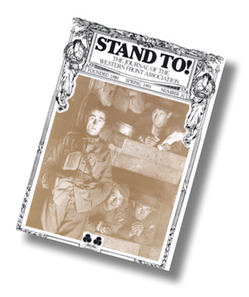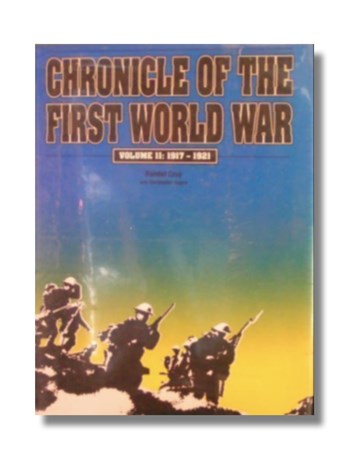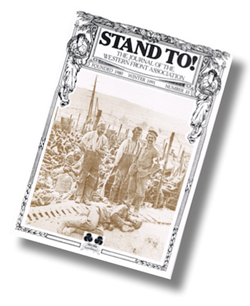Chronicle of the First World War Vol I & Vol II by Ronald Gray and Christopher Argyle
- Home
- World War I Book Reviews
- Chronicle of the First World War Vol I & Vol II by Ronald Gray and Christopher Argyle


Chronicle of the First World War Vol I
356 pp. Casebound. £20. Facts on File. 1990. ISBN 0 8160 2139 2.

[This review first appeared in Stand To! No. 31 Spring 1991]
Just occasionally a book appears that may correctly be described as 'important': this is such a work so far as Great War addicts are concerned.
Chronicle of the First World War Vol I 1914-1916 concisely sets out day by day the relevant events of that conflict under nine different columns such as Western Front, Turkish Fronts, Sea War, International Events and Home Fronts. Thus to get a synopsis of events on, say, the Western Front, one has merely to look down the relevant column.
The date of the particular occurrence can be ascertained by glancing across to the first column. The layout is therefore similar, but more detailed, than Gleichen's Chronology of the Great War reissued by Greenhill Books in 1988. However, the three volumes of that work were originally published between 1918 and 1920 and used The Times as their basis. Since that newspaper was compiled under wartime conditions, the entries bore the stamp of official bulletins. That for 1 July 1916, for example, speaks of the British breaking through towards Bapaume and gives no inkling of the disaster that befell the British Army that day. Thus, valuable though that work is, it cannot compare with the more objective and comprehensive approach of this latest work.
There are essays for each year, useful tables of statistics, some very clear maps, a glossary, and an index to main events, all of which enhance its value.
An impressive list of sources includes Gerald Gliddon's First World War: List of 700 Books in Print and Stand To!
In a work of this size, there are bound to be mistakes whilst some readers may have their own ideas as to what should, or should not, be included.
There are some little gems included. Did you know, for example, that on 22 September 1914 700 Belgian volunteer cyclists rode out from Antwerp and cut German rail communications in three provinces, or that on 25 October 1915 South Africa started recruiting coloured people for the 1st Cape Corps? I didn't.
I can recommend this book as being a very useful one for the student of the Great War. You should at least ask your librarian to get a copy for his reference library. It is a well produced work and its cost is not prohibitive even if this volume only takes us to the end of 1916.
The second volume 1917-18 is due to be published in October 1991.
Review by Bob Butcher

Chronicle of the First World War Vol II 1917-1921
383 pp. Casebound. £21.95. Facts on File. 1991. ISBN 0 8160 2595 9.

[This review first appeared in Stand To! No. 33 Winter 1991]
Those with access to the first volume of this work (reviewed in S T /31), will have been eagerly awaiting this volume which takes us up to the conclusion of peace in 1921. They will not be disappointed.
The format is the same: a tremendous amount of information compressed into day by day entries in nine columns headed respectively, Western Front, Eastern Front, Southern Fronts, Turkish Fronts, African Operations, Sea War, Air War, International Events, and Home Fronts.
I wanted to find out something about the introduction of conscription in Britain and was able to get the salient points by glancing down the Home Fronts columns of both volumes. Similarly I took one day—11 April 1918— more or less at random and looking across discovered that, in ter alia, we lost Hill 63, the Bolsheviks liquidated anarchist clubs, the Austrians decided to concentrate their spring offensive on the Trentino, 4000 Turks failed to retake Ghoraniyeh in Palestine, the King's African Rifles suffered more than forty casualties in an engagement with the Germans, the Dover Patrol shelled Ostend, fourteen Handley Page bombers set out to attack the Zeebrugge area but only four succeeded and two failed to return, it was claimed that British PoWs were being maltreated, and in Britain waste-paper collection reached 4000 tons per month.
There are some useful tables, a 'who's who', very clear maps for each theatre, a comprehensive list of sources, a quite good glossary, and an adequate index.
Perhaps not all members will wish—or be able to afford—to own a copy, but there should certainly be one in every reference library worthy of its name.
Why not speak to your local librarian about it? (The two volume set costs £39.95. 0-8160-2597-5).
Review by Bob Wyatt
[Online new copies are available for between £62 and £104 while a second hand copies can be found for as little as £4.25. Digital Editor, January 2022]





